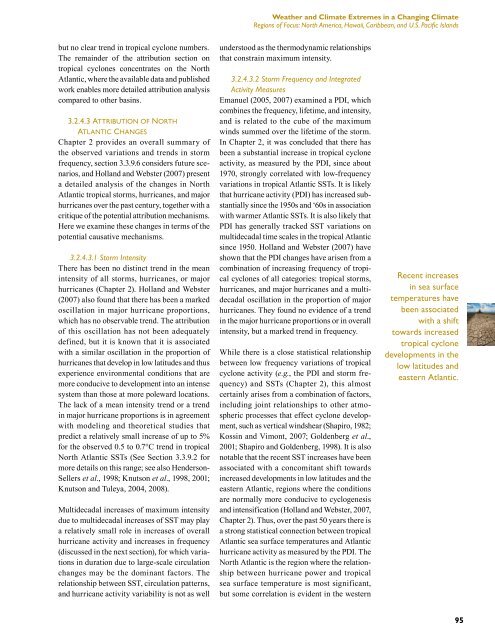Weather and Climate Extremes in a Changing Climate. Regions of ...
Weather and Climate Extremes in a Changing Climate. Regions of ...
Weather and Climate Extremes in a Changing Climate. Regions of ...
Create successful ePaper yourself
Turn your PDF publications into a flip-book with our unique Google optimized e-Paper software.
ut no clear trend <strong>in</strong> tropical cyclone numbers.<br />
The rema<strong>in</strong>der <strong>of</strong> the attribution section on<br />
tropical cyclones concentrates on the North<br />
Atlantic, where the available data <strong>and</strong> published<br />
work enables more detailed attribution analysis<br />
compared to other bas<strong>in</strong>s.<br />
3.2.4.3 attributiOn Of nOrth<br />
atlantiC Changes<br />
Chapter 2 provides an overall summary <strong>of</strong><br />
the observed variations <strong>and</strong> trends <strong>in</strong> storm<br />
frequency, section 3.3.9.6 considers future scenarios,<br />
<strong>and</strong> Holl<strong>and</strong> <strong>and</strong> Webster (2007) present<br />
a detailed analysis <strong>of</strong> the changes <strong>in</strong> North<br />
Atlantic tropical storms, hurricanes, <strong>and</strong> major<br />
hurricanes over the past century, together with a<br />
critique <strong>of</strong> the potential attribution mechanisms.<br />
Here we exam<strong>in</strong>e these changes <strong>in</strong> terms <strong>of</strong> the<br />
potential causative mechanisms.<br />
3.2.4.3.1 Storm Intensity<br />
There has been no dist<strong>in</strong>ct trend <strong>in</strong> the mean<br />
<strong>in</strong>tensity <strong>of</strong> all storms, hurricanes, or major<br />
hurricanes (Chapter 2). Holl<strong>and</strong> <strong>and</strong> Webster<br />
(2007) also found that there has been a marked<br />
oscillation <strong>in</strong> major hurricane proportions,<br />
which has no observable trend. The attribution<br />
<strong>of</strong> this oscillation has not been adequately<br />
def<strong>in</strong>ed, but it is known that it is associated<br />
with a similar oscillation <strong>in</strong> the proportion <strong>of</strong><br />
hurricanes that develop <strong>in</strong> low latitudes <strong>and</strong> thus<br />
experience environmental conditions that are<br />
more conducive to development <strong>in</strong>to an <strong>in</strong>tense<br />
system than those at more poleward locations.<br />
The lack <strong>of</strong> a mean <strong>in</strong>tensity trend or a trend<br />
<strong>in</strong> major hurricane proportions is <strong>in</strong> agreement<br />
with model<strong>in</strong>g <strong>and</strong> theoretical studies that<br />
predict a relatively small <strong>in</strong>crease <strong>of</strong> up to 5%<br />
for the observed 0.5 to 0.7°C trend <strong>in</strong> tropical<br />
North Atlantic SSTs (See Section 3.3.9.2 for<br />
more details on this range; see also Henderson-<br />
Sellers et al., 1998; Knutson et al., 1998, 2001;<br />
Knutson <strong>and</strong> Tuleya, 2004, 2008).<br />
Multidecadal <strong>in</strong>creases <strong>of</strong> maximum <strong>in</strong>tensity<br />
due to multidecadal <strong>in</strong>creases <strong>of</strong> SST may play<br />
a relatively small role <strong>in</strong> <strong>in</strong>creases <strong>of</strong> overall<br />
hurricane activity <strong>and</strong> <strong>in</strong>creases <strong>in</strong> frequency<br />
(discussed <strong>in</strong> the next section), for which variations<br />
<strong>in</strong> duration due to large-scale circulation<br />
changes may be the dom<strong>in</strong>ant factors. The<br />
relationship between SST, circulation patterns,<br />
<strong>and</strong> hurricane activity variability is not as well<br />
<strong>Weather</strong> <strong>and</strong> <strong>Climate</strong> <strong>Extremes</strong> <strong>in</strong> a Chang<strong>in</strong>g <strong>Climate</strong><br />
<strong>Regions</strong> <strong>of</strong> Focus: North America, Hawaii, Caribbean, <strong>and</strong> U.S. Pacific Isl<strong>and</strong>s<br />
understood as the thermodynamic relationships<br />
that constra<strong>in</strong> maximum <strong>in</strong>tensity.<br />
3.2.4.3.2 Storm Frequency <strong>and</strong> Integrated<br />
Activity Measures<br />
Emanuel (2005, 2007) exam<strong>in</strong>ed a PDI, which<br />
comb<strong>in</strong>es the frequency, lifetime, <strong>and</strong> <strong>in</strong>tensity,<br />
<strong>and</strong> is related to the cube <strong>of</strong> the maximum<br />
w<strong>in</strong>ds summed over the lifetime <strong>of</strong> the storm.<br />
In Chapter 2, it was concluded that there has<br />
been a substantial <strong>in</strong>crease <strong>in</strong> tropical cyclone<br />
activity, as measured by the PDI, s<strong>in</strong>ce about<br />
1970, strongly correlated with low-frequency<br />
variations <strong>in</strong> tropical Atlantic SSTs. It is likely<br />
that hurricane activity (PDI) has <strong>in</strong>creased substantially<br />
s<strong>in</strong>ce the 1950s <strong>and</strong> ‘60s <strong>in</strong> association<br />
with warmer Atlantic SSTs. It is also likely that<br />
PDI has generally tracked SST variations on<br />
multidecadal time scales <strong>in</strong> the tropical Atlantic<br />
s<strong>in</strong>ce 1950. Holl<strong>and</strong> <strong>and</strong> Webster (2007) have<br />
shown that the PDI changes have arisen from a<br />
comb<strong>in</strong>ation <strong>of</strong> <strong>in</strong>creas<strong>in</strong>g frequency <strong>of</strong> tropical<br />
cyclones <strong>of</strong> all categories: tropical storms,<br />
hurricanes, <strong>and</strong> major hurricanes <strong>and</strong> a multidecadal<br />
oscillation <strong>in</strong> the proportion <strong>of</strong> major<br />
hurricanes. They found no evidence <strong>of</strong> a trend<br />
<strong>in</strong> the major hurricane proportions or <strong>in</strong> overall<br />
<strong>in</strong>tensity, but a marked trend <strong>in</strong> frequency.<br />
While there is a close statistical relationship<br />
between low frequency variations <strong>of</strong> tropical<br />
cyclone activity (e.g., the PDI <strong>and</strong> storm frequency)<br />
<strong>and</strong> SSTs (Chapter 2), this almost<br />
certa<strong>in</strong>ly arises from a comb<strong>in</strong>ation <strong>of</strong> factors,<br />
<strong>in</strong>clud<strong>in</strong>g jo<strong>in</strong>t relationships to other atmospheric<br />
processes that effect cyclone development,<br />
such as vertical w<strong>in</strong>dshear (Shapiro, 1982;<br />
Koss<strong>in</strong> <strong>and</strong> Vimont, 2007; Goldenberg et al.,<br />
2001; Shapiro <strong>and</strong> Goldenberg, 1998). It is also<br />
notable that the recent SST <strong>in</strong>creases have been<br />
associated with a concomitant shift towards<br />
<strong>in</strong>creased developments <strong>in</strong> low latitudes <strong>and</strong> the<br />
eastern Atlantic, regions where the conditions<br />
are normally more conducive to cyclogenesis<br />
<strong>and</strong> <strong>in</strong>tensification (Holl<strong>and</strong> <strong>and</strong> Webster, 2007,<br />
Chapter 2). Thus, over the past 50 years there is<br />
a strong statistical connection between tropical<br />
Atlantic sea surface temperatures <strong>and</strong> Atlantic<br />
hurricane activity as measured by the PDI. The<br />
North Atlantic is the region where the relationship<br />
between hurricane power <strong>and</strong> tropical<br />
sea surface temperature is most significant,<br />
but some correlation is evident <strong>in</strong> the western<br />
Recent <strong>in</strong>creases<br />
<strong>in</strong> sea surface<br />
temperatures have<br />
been associated<br />
with a shift<br />
towards <strong>in</strong>creased<br />
tropical cyclone<br />
developments <strong>in</strong> the<br />
low latitudes <strong>and</strong><br />
eastern Atlantic.<br />
95




